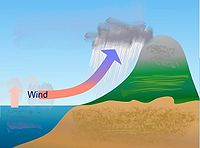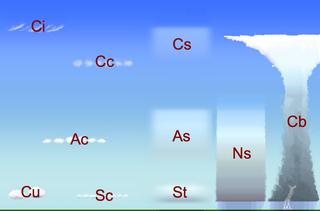Basic Geography/Climate/Climate Elements
Temperature
[edit | edit source]Temperature is the degree of hotness or coldness of the atmosphere on some chosen scale. It is commonly measured in Celsius or Fahrenheit. Temperature is a very important factor in determining the weather, because it influences other elements of the weather.
Temperature may be affected by:
- Sunshine
- Latitude
- Altitude
- Aspect
- Sea Proximity and Temperature
- Ocean Currents
- Prevailing Winds
Sunshine
[edit | edit source]The amount of sunshine at a certain place can influence its temperature. The amount of sunshine can be measured in sunshine hours. That is worked out by the number of hours of daylight and how many of these are cloud free. Sunshine is variable due to daylight hours as during the night there is no sunshine as the Earth is pointing away from the sun at the given spot. Also due to the Earth's tilt some times of the year have more sunshine (summer) and some less (winter).
Latitude
[edit | edit source]Latitude is the distance of a location from the equator. The hottest temperatures on Earth are found near the equator. This is because the sun shines directly on it for more hours during the year than anywhere else. As you move further away from the equator towards the poles, less sun is received during the year and the temperature become colder.
Altitude
[edit | edit source]Altitude is the height you are above sea level. The higher up you are the lower the temperature will be. This is because air that is higher up is less dense than it is at lower altitudes and air temperature depends on its density. As a general rule for every 1,000m higher you go the temperature will drop by 6.5 °C.
Aspect
[edit | edit source]Aspect is the direction in which you are facing. So if you are facing towards the equator then the temperature will be warmer than facing away. Therefore in the Northern Hemisphere if you wanted to lie in the sun on a hillside you would do so on the south facing slope (if you were in the Southern Hemisphere it would be the North Facing Slope).
Sea Proximity and Temperature
[edit | edit source]Sea temperature changes slower than land temperature. If the temperature on land drops then the area next to the sea will be kept warmer for longer than areas inland. Islands therefore have a less dramatic climate than continents. Different seas have different temperatures therefore allowing one side of an island to be a different temperature to the other side.
Ocean Currents
[edit | edit source]Currents are driven by the prevailing winds passing over the surface of the ocean. Therefore winds blowing from tropical areas bring warm currents and vice versa. The temperature of the current also affects the humidity of the air above it. Warm currents bring higher humidity than do cold currents.
Prevailing Winds
[edit | edit source]Winds acquire the properties (temperature and humidity) of the places they pass over. Prevailing winds that accompany a warm ocean current, tend to warm adjacent land. Scotland is an example as the North Atlantic Drift provides warmth picked up by the prevailing Westerlies of the mid-latitudes. Winds that originated over land at this latitude, for example those Westerlies reaching Labrador, Canada, are much colder. This is due to the thermal properties of land and water. Water warms and cools more slowly than does land. Inland, places are generally warmer in summer and cooler in winter than places on a coast. For example, London (near the coast) has warmer winters and cooler summers than does Kyiv (well inland), although both are at a similar latitude and receive Westerlies as the prevailing wind.
Humidity
[edit | edit source]Humidity is the level of water in the air, the more water vapour in the air the higher the humidity. If the humidity level exceeds the amount of water air can hold, condensation occurs forming dew if it's warm or frost if it's cold. When air is at a high altitude and has a high humidity then clouds start to form. Humidity varies with temperature. Warmer air can hold more moisture.
Precipitation
[edit | edit source]Precipitation is the term given to moisture that falls from the air to the ground. Precipitation can be snow, hail, sleet, drizzle, fog, mist and rain. The water cycle drives the water from the oceans/seas on-shore where it falls as precipitation and then flows via rivers back into the sea.
Types of Rainfall
[edit | edit source]
- Convectional Rainfall
This is where a water surface is heated by the sun, e.g. the sea. The air above the sea then becomes heated making the air less dense so it rises and cools. As we know cooler air can not hold as much water vapour as warm air therefore when the rising air becomes too cold to hold the moisture the condensation occurs giving us clouds. Once there is too much water in the cloud for the air to support gravity forces the water to be released in what we know as rain.
- Frontal Rainfall
When two air masses meet where one is warmer than the other, the warmer air is forced to rise over the colder, denser, air. As this warm air rises it cools and forms clouds just like the air in convectional rainfall. This occurs at fronts (warm, cold and occluded).

- Relief Rainfall
Wind bringing moist air from the seashore starts to rise up the (windward) side of a mountain. As this air rises, the air passes its Dew Point, the point at which condensation occurs, and the vapour condenses on microscopic dust particle (hygroscopic nuclei) to forms clouds. The microscopic droplets collide with each other to form larger drops which eventually fall by gravity as precipitation on the top of the mountain. As the air descends the other (leeward) side of the mountain, it warms (effect of altitude loss), causing condensation and, therefore rain, to stop. The area leeward to a mountain has relatively lower levels of precipitation and is known as the rain shadow. Examples of areas with high relief rainfall are western Britain (Pennines), the northwest Pacific coast of the United States (Cascades), the Cantabrian Mountains of Spain, and the Himalayas. The rain shadows for these areas are eastern Scotland, the Great Basin, the northern Sub-Plateau (Meseta), and the Tibetan Plateau.
Cloud Types
[edit | edit source]
Clouds are split into different groups depending on their height, shape and size. The most common terms are:
- Cirrus - Wispy, white clouds found at high altitudes
- Cumulus - Fluffy or heaped white clouds at relatively low altitudes
- Stratus - Low altitude layered cloud very rarely bringing precipitation
- Nimbus - Rain Clouds
- Cirro - High Altitude Clouds
- Alto - Medium Altitude cloud
The above terms are put together to form names of certain clouds:
- Cumulonimbus - Very large clouds bringing heavy rain, notice how the name comes from cumulus and nimbus above.
Air Pressure and Wind
[edit | edit source]Air pressure is simply the weight of the air above the Earth. Low Pressure is when air is warmer and therefore lighter. High pressure is colder air becoming heavier.
In meteorology pressure is charted on maps with isobars. The higher the number the higher the pressure.
Wind is simply the movement of air from high pressure to low pressure. The speed of the wind is determined by the difference between the high and low pressure. The greater the difference the faster the wind speed. Also the closer the isobars are on a weather chart the stronger the winds.
The wind brings with it the temperature of the area it is coming from, therefore a high pressure in a warm region will make the temperature in the low pressure area higher.
Wind-chill is the effect of the wind making it feel colder than it actually is. As the wind speed increases air is moving more quickly and therefore removes warm air, making it seem colder than the actual temperature.